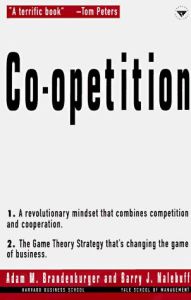Join getAbstract to access the summary!

Join getAbstract to access the summary!
Adam M. Brandenburger and Barry J. Nalebuff
Co-opetition
1. A Revolutionary Mindset that Combines Competition and Cooperation. 2. The Game Theory Strategy that’s Changing the Game of Business.
Doubleday Broadway, 1997
What's inside?
Use the rules of game theory to think strategically about your organization and the decisions you make. Play the game.
Recommendation
Professor of business economics and strategy Adam M. Brandenburger and professor of management Barry J. Nalebuff show you how to apply game theory to your business. They say you will be able to think more strategically if you recognize that all business relationships involve games that consist of five basic elements: “players, added values, rules, tactics and scope,” or “PARTS” for short. Thinking about your business in game terms empowers you to recognize competitive and complementary relationships where your business will benefit from another company’s products or services. The book’s first section discusses the key principles of game theory, while the second section shows you how to improve the way you play. The authors highlight the main principles in capsule summaries. This clearly written strategy manual illustrates its main points with real-world examples of successful and unsuccessful corporate game playing. getAbstract recommends it to strategic thinkers and negotiators in any business.
Summary
About the Authors
Adam M. Brandenburger is a professor at the Harvard Business School. Barry J. Nalebuff, a professor at the Yale School of Management, is the co-author of Thinking Strategically.









Comment on this summary